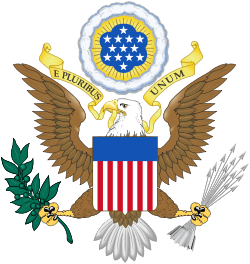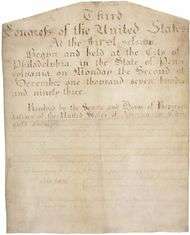Eleventh Amendment to the United States Constitution
| This article is part of a series on the |
| Constitution of the United States of America |
|---|
 |
|
Preamble and Articles of the Constitution |
| Amendments to the Constitution |
|
|
| Unratified Amendments |
| History |
| Full text of the Constitution and Amendments |
|

The Eleventh Amendment (Amendment XI) to the United States Constitution, which was passed by Congress on March 4, 1794, and ratified by the states on February 7, 1795, deals with each state's sovereign immunity and was adopted to overrule the U.S. Supreme Court's decision in Chisholm v. Georgia, 2 U.S. 419 (1793).[1]
Text
The Judicial power of the United States shall not be construed to extend to any suit in law or equity, commenced or prosecuted against one of the United States by Citizens of another State, or by Citizens or Subjects of any Foreign State.
Background
The Eleventh Amendment was the first Constitutional amendment adopted after the Bill of Rights. The amendment was adopted following the Supreme Court's ruling in Chisholm v. Georgia, 2 U.S. 419 (1793). In Chisholm, the Court ruled that federal courts had the authority to hear cases in law and equity brought by private citizens against states and that states did not enjoy sovereign immunity from suits made by citizens of other states in federal court. Thus, the amendment clarified Article III, Section 2 of the Constitution, which gives diversity jurisdiction to the judiciary to hear cases "between a state and citizens of another state."
Proposal and ratification
The Eleventh Amendment was proposed by the 3rd Congress on March 4, 1794, when it was approved by the House of Representatives by vote of 81 – 9,[2] having been previously passed by the Senate, 23 – 2, on January 14, 1794.[3] The amendment was ratified by the state legislatures of the following states:[4]
- New York — March 27, 1794
- Rhode Island — March 31, 1794
- Connecticut — May 8, 1794
- New Hampshire — June 16, 1794
- Massachusetts — June 26, 1794
- Vermont — November 9, 1794
- Virginia — November 18, 1794
- Georgia — November 29, 1794
- Kentucky — December 7, 1794
- Maryland — December 26, 1794
- Delaware — January 23, 1795
- North Carolina — February 7, 1795
As there were 15 States at the time, the ratification by twelve States added the Eleventh Amendment to the Constitution. It was subsequently ratified by: - South Carolina — December 4, 1797
On January 8, 1798, approximately three years after the Eleventh Amendment's adoption, President John Adams stated in a message to Congress that the Eleventh Amendment had been ratified by the necessary number of States and that it was now a part of the Constitution of the United States.[5] New Jersey and Pennsylvania did not take action on the amendment; neither did Tennessee, which had become a State on June 16, 1796.
Impact
Retroactivity
In Hollingsworth v. Virginia, 3 U.S. 378 (1798), the Supreme Court held that every pending action brought under Chisholm had to be dismissed because of the amendment's adoption.[6]
Sovereign immunity
The amendment's text does not mention suits brought against a state by its own citizens. However, in Hans v. Louisiana, 134 U.S. 1 (1890), the Supreme Court ruled that the amendment reflects a broader principle of sovereign immunity. As Justice Anthony Kennedy later stated in Alden v. Maine, 527 U.S. 706 (1999):
[S]overeign immunity derives not from the Eleventh Amendment but from the structure of the original Constitution itself. ... Nor can we conclude that the specific Article I powers delegated to Congress necessarily include, by virtue of the Necessary and Proper Clause or otherwise, the incidental authority to subject the States to private suits as a means of achieving objectives otherwise within the scope of the enumerated powers.[7]
However, Justice David Souter, writing for a four-Justice dissent in Alden, said the states surrendered their sovereign immunity when they ratified the Constitution. He read the amendment's text as reflecting a narrow form of sovereign immunity that limited only the diversity jurisdiction of the federal courts. He concluded that the states are not insulated from suits by individuals by either the Eleventh Amendment in particular or the Constitution in general.[8]
Application to federal law
Although the Eleventh Amendment grants immunity to states from suit for money damages or equitable relief without their consent, in Ex parte Young, 209 U.S. 123 (1908), the Supreme Court ruled that federal courts may enjoin state officials from violating federal law. In Fitzpatrick v. Bitzer, 427 U.S. 445 (1976), the Supreme Court ruled that Congress may abrogate state immunity from suit under Section 5 of the Fourteenth Amendment. In Central Virginia Community College v. Katz, 546 U.S. 356 (2006), the Court ruled the Congress could do the same regarding bankruptcy cases by way of Article I, Section 8, Clause 4 of the Constitution. In Lapides v. Board of Regents of Univ. System of Ga., 535 U.S. 613 (2002), the Supreme Court ruled that when a state invokes a federal court's removal jurisdiction, it waives the Eleventh Amendment in the removed case.
Territorial application
The United States Court of Appeals for the First Circuit has ruled that Puerto Rico enjoys Eleventh Amendment immunity.[9]
References
- ↑ "Annotation 1 - Eleventh Amendment - State Immunity". FindLaw. Retrieved May 4, 2013.
- ↑ "4 Annals of Congress 477 (1795)". Retrieved April 18, 2014.
- ↑ "4 Annals of Congress 30 (1795)". Retrieved April 18, 2014.
- ↑ "The Constitution of the United States of America: Analysis and Interpretation, Centennial Edition, Interim Edition: Analysis of Cases Decided by the Supreme Court of the United States to June 26, 2013" (PDF). Washington, DC: U.S. Government Printing Office. 2013. p. 42. Retrieved April 13, 2014.
- ↑ "7 Annals of Congress 809 (1798)". Retrieved April 18, 2014.
- ↑ Opinion of the Court in Hollingsworth v. Virginia
- ↑ Opinion of the Court in Alden v. Maine
- ↑ Dissenting opinion in Alden v. Maine
- ↑ e.g., Ramirez v. Puerto Rico Fire Service and Office of Personnel (1st Cir. 1983).
External links
- Clark, Bradford R. (2010). "The Eleventh Amendment and the Nature of the Union" (PDF). Harvard Law Review. 123 (8): 1817–1918. Archived from the original (PDF) on 15 January 2013.
- National Archives: Eleventh Amendment
- CRS Annotated Constitution: Eleventh Amendment
- Leaving the Chisholm Trail